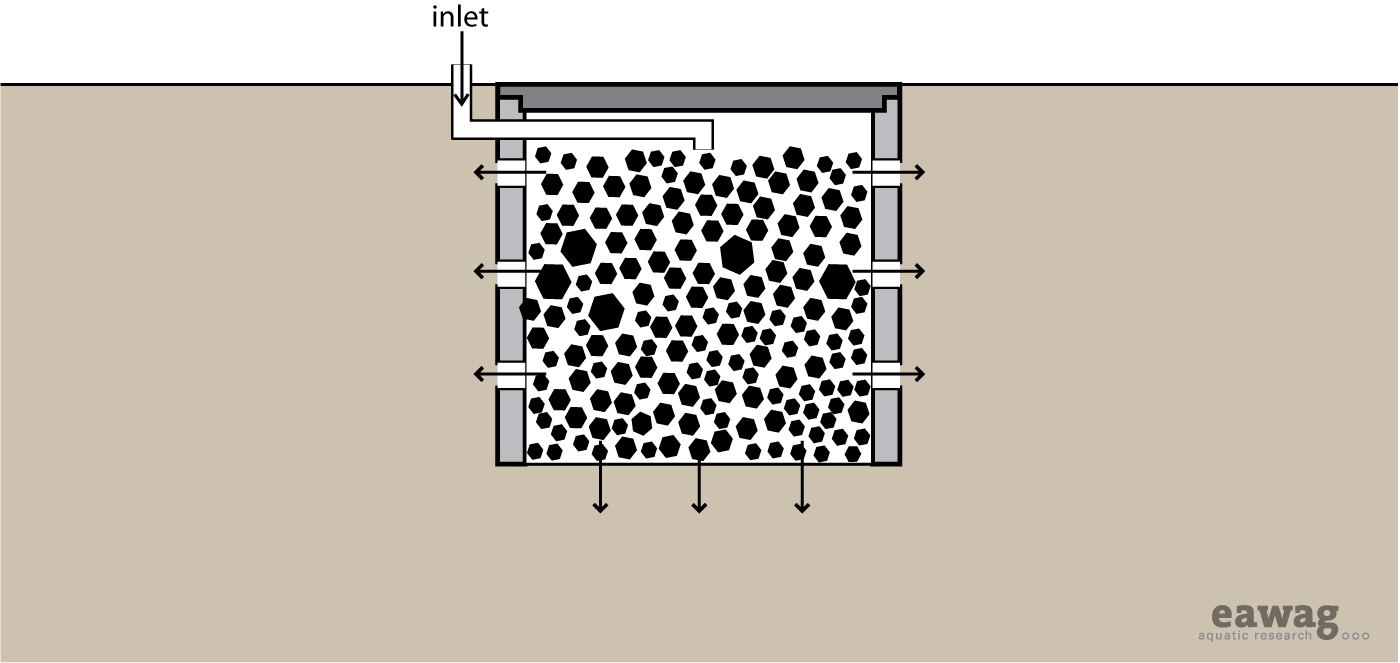Difference between revisions of "Soak Pit"
| Line 20: | Line 20: | ||
}} | }} | ||
| − | + | [[Image:Icon_soak_pit.png |right|95px]] | |
'''A Soak Pit, also known as a soakaway or leach pit, is a covered, porous-walled chamber that allows water to slowly soak into the ground. Pre-settled effluent from a Collection and Storage/Treatment or (Semi-) Centralized Treatment technology is discharged to the underground chamber from where it infiltrates into the surrounding soil.''' | '''A Soak Pit, also known as a soakaway or leach pit, is a covered, porous-walled chamber that allows water to slowly soak into the ground. Pre-settled effluent from a Collection and Storage/Treatment or (Semi-) Centralized Treatment technology is discharged to the underground chamber from where it infiltrates into the surrounding soil.''' | ||
Revision as of 13:34, 5 March 2009
|

|
|
| |||||||||||||||||||||||||||||||
A Soak Pit, also known as a soakaway or leach pit, is a covered, porous-walled chamber that allows water to slowly soak into the ground. Pre-settled effluent from a Collection and Storage/Treatment or (Semi-) Centralized Treatment technology is discharged to the underground chamber from where it infiltrates into the surrounding soil.
The Soak Pit can be left empty and lined with a porous material (to provide support and prevent collapse), or left unlined and filled with coarse rocks and gravel. The rocks and gravel will prevent the walls from collapsing, but will still provide adequate space for the wastewater. In both cases, a layer of sand and fine gravel should be spread across the bottom to help disperse the flow. The soak pit should be between 1.5 and 4m deep, but never less than 1.5m above the ground water table.
As wastewater (pre-treated greywater or blackwater) percolates through the soil from the Soak Pit, small particles are filtered out by the soil matrix and organics are digested by micro-organisms. Thus, Soak Pits are best suited to soils with good absorptive properties; clay, hard packed or rocky soils are not appropriate.
| Advantages | Disadvantages/limitations |
|---|---|
| - Can be built and repaired with locally available materials. - Small land area required. - Low capital cost; low operating cost. - Can be built and maintained with locally available materials. - Simple technique for all users. |
- Pretreatment is required to prevent clogging, although eventual clogging is inevitable. - May negatively affect soil and groundwater properties. |
Adequacy
A Soak Pit does not provide adequate treatment for raw wastewater and the pit will clog quickly. A Soak Pit should be used for discharging presettled blackwater or greywater. Soak pits are appropriate for rural and peri-urban settlements. They depend on soil with a sufficient absorptive capacity. They are not appropriate for areas that are prone to flooding or have high groundwater tables.
Health Aspects/Acceptance
As long as the Soak Pit is not used for raw sewage, and as long as the previous Collection and Storage/Treatment technology is functioning well, health concerns are minimal. The technology is located underground and thus, humans and animals should have no contact with the effluent. It is important however, that the Soak Pit is located a safe distance from a drinking water source (ideally 30m). Since the Soak Pit is odourless and not visible, it should be accepted by even the most sensitive communities.
Maintenance
A well-sized Soak Pit should last between 3 and 5 years without maintenance. To extend the life of a Soak Pit, care should be taken to ensure that the effluent has been clarified and/or filtered well to prevent excessive build up of solids. The Soak Pit should be kept away from high-traffic areas so that the soil above and around it is not compacted. When the performance of the Soak Pit deteriorates, the material inside the soak pit can be excavated and refilled. To allow for future access, a removable (preferably concrete) lid should be used to seal the pit until it needs to be maintained.
Particles and biomass will eventually clog the pit and it will need to be cleaned or moved.
References
- Elizabeth Tilley et.al (2008). Compendium of Sanitation Systems and Technologies (low res version). Department of Water and Sanitation in Development Countries (Sandec) at the Swiss Federal Institute of Aquatic Science and Technology (Eawag). (Provides a full overview of sanitation systems.)
- Ahrens, B. (2005). A Comparison of Wash Area and Soak Pit Construction: The Changing Nature of Urban, Rural, and Peri-Urban Linkages in Sikasso, Mali. Peace Corp, USA. Available: http://www.cee.mtu.edu/peacecorps/reports/Brooke
- Ahrens_Final_Report.pdf (Detailed construction instructions)
- Mara, DD. (1996). Low-Cost Urban Sanitation. Wiley, Chichester, UK. pp 63–65. (Dimensioning calculations)
- Polprasert, C. and Rajput, VS. (1982). Environmental Sanitation Reviews: Septic Tank and Septic Systems. Environmental Sanitation Information Center, AIT, Bangkok, Thailand. pp 31–58.
